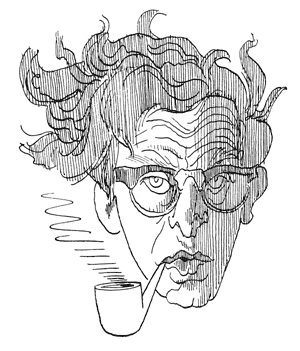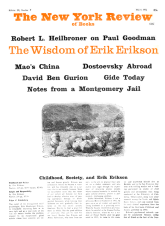Paul Goodman has written an important book, about which I have thought harder than any other book I can remember reading for a long while. I think it likely that his book will strike a live nerve, not only on the campuses where Mr. Goodman is already a considerable culture hero, but in Washington, and along Foundation Boulevard. I would be happy if it did, for the book offers suggestions for social improvement that are worth following up, and it forces its readers to reconsider ideas that no longer seemed worth the bother of fresh examination. At the same time that I offer these warm commendations, however, I must add that I also find a grave weakness in the book—a weakness that will in the end, I believe, severely limit its applicability and the degree of esteem it will permanently merit.
Mr. Goodman would be the first to admit that the central theme of his book is not new. It is a cri de coeur, in the grand tradition of humanistic dissent, against the stupefying bigness, the sapping but self-sustaining routine, the quantitative victories bought at the price of qualitative defects, typical of contemporary society. At the same time, it is also a plea, in the same venerable tradition, for a society refashioned so as to leave more space, more choice, more chance for engagement for individual man. The operative principle—at once the problem and the lever for change—is the technical organization of society. In Mr. Goodman’s opening words:
Throughout society, the centralizing style of organization has been pushed so far as to become ineffectual, economically wasteful, humanly stultifying, and ruinous to democracy…The only remedy is a strong admixture of decentralism. The problem is where, how much, and how to go about it.
I can feel the reader stiffen: everyone knows that decentralization is “impossible” in the face of modern technology, etc., etc. A strength of Mr. Goodman’s book is that he also knows this, and is not hesitant to urge more centralism in some areas than we have now—for instance in the standardized production of the basic necessities of life. (Of the problems this poses, more later.) But the point is that Mr. Goodman is not a doctrinaire organizational Leveller nor an arts-and-crafts enthusiast with a Mission. He is aware that contemporary society requires central direction and coordination in many of its activities. The case he wishes to make is that its centralism need not be, as is now so often the case, a mere yielding before routine, and that decentralized forms of organization may find application in many areas of society now needlessly consigned to bureaucracy.
I do not propose to pass on the practicability of all his suggestions, but only to pass some of them along to give a flavor of his inventiveness. The schools are a particular target of Mr. Goodman’s decentralizing animus. He wants them administratively handed back to the localities in which they are rooted, and reduced in size—down to tiny vestpocket schools for Harlem children. He wants bright underachievers given the chance to find motivation by being given subsidized apprenticeships in interesting places to work and to learn, such as radio stations, newspapers, little theaters, etc. Incidentally, he would also like to see many police functions given back to the control of the city.
Work is another target for decentralization. Goodman suggests that factory work should be organized, wherever possible, into gang units who would set their own work rules, their own pace and timing, within recognized limits. Let office workers, too, be responsible for their work and not for merely serving time, and let them come and go as they please or do their work at home if they can. Do not let the small farm go under in the name of “economies” of large-scale farm production, balanced by the uncounted dis-economies of bankrupt farmers who have become city charges. Subsidize the small farmer and let him earn a decent livelihood doing work that he understands.
In a word, wherever it can be done—and it is refreshing to discover how many overlooked possibilities there may be—Mr. Goodman presses for the small over the big, for the informal over the formal, for the neighborly over the impersonal. In education and cultural enterprises as well as in business and government he is committed to the notion that “personnel”—the units of humanity administered within largescale organizations—can become people only if they are given an environment scaled down to the point at which an individual’s effort again becomes a recognizable entity.
After so much praise, I must be candid enough to admit that I have my misgivings about some of these suggestions. There is a certain anecdotal quality to Mr. Goodman’s style of thought—an instance, casually tossed out on one page, becomes an anchor of reference a few pages later. And there is at least one matter in which I find myself taken aback by his airy assurance: Mr. Goodman’s suggestions in regard to economic development are about at the Reader’s Digest level: give them some good advice and the basic tools and they’ll do the job, but don’t corrupt their healthy cultures by sending in “the high standard and elaborate capital” of a technologically advanced civilization since this can only result in cultural corruption and disruption.
Advertisement
If the same cavalier over-simplification of complex problems pervades other suggestions, then his book would be only a brochure of deception. But I do not think this is the case. At any rate, Mr. Goodman disarms me with his frankly experimental approach, and he convinces me that a great deal of what he suggests is worth a serious try. I hope that those who run the poverty programs, education programs, foundation programs and all the other programmatic efforts to improve the quality of existence will take this much of the book to heart.
If it were no more than just a collection of recipes for organizational innovation, I would stop here. But there is a deeper message in Mr. Goodman’s tract to which I must now direct some less affirmative words. For Mr. Goodman is not really content just to introduce a few breathing spaces into a suffocating society. At bottom, he wishes to refashion society on the grand scale, to write his program for humanism large.
The reformed social organization that Mr. Goodman projects will be familiar to those who have read Communitas, the book on city planning by Goodman and his brother. In this society the necessaries of life will be regularized and produced with the smallest possible quantum of social labor time (which may be very small indeed), and made available on some equitable basis to all. By way of integrating this necessarily centralized flow of production with opportunities for individual effort, Mr. Goodman shows a nice ingenuity—he suggests, for instance, quadrennial competitions for automobile design, after which the new standardized line is again turned out at minimum cost until the next occasion for competitive redesign. (I am reminded of Fourier’s contests of champagne growers and omelette chefs.) But social life really begins above this sector of assured and guaranteed social sustenance in the much larger decentralized zone—here are the small shops, the truly private enterprises, the community health and recreation projects, the vast and varied enterprise of education, the provision of social service for the very young and the very old.
I have no fault to find with this landscape, which might be a much better place in which to grow humanity than the one we have now (although I suspect the amount of centralism needed to run even a modest subsistence sector might be larger than we are likely to imagine). Rather, what concerns me is whether such a society lies within the evolutionary limits of our own society—and if it does not, what degree of responsibility attaches to the man who writes the travel folder about it. Not to mince words, I do not think it does lie within our present evolutionary capabilities. The private ownership of the massive means of production, the hegemony of the market and the structure of incomes (particularly upper incomes) that rests on this market, the legal network of contractual obligations of a capitalist system—all this would have to go before the subsistence sector could be accomplished. To put it differently, a whole new social order, based on the public control over basic industrial output, on strict planning in the industrial sector, and on the institution of some new form of economic controls over the individual would have to precede Mr. Goodman’s society. The old-fashioned word for the passage beyond one set of property, legal, and social arrangements into another was revolution. But nowhere does Mr. Goodman suggest that this might have to be the price we would have to pay for admission to his Promised Land.
I do not wish to be doctrinaire myself, in making this delineation between evolutionary and revolutionary goals for society. I am aware of the considerable, rather indeterminate, accommodations of social structures compatible with the fundamental property relationships of capitalism—I think of the “capitalisms” of Proust, Mann. Sinclair Lewis, and J. P. Marquand. Nonetheless, I also think there are boundaries of change beyond which one cannot evolve but must burst, and I think it would take such a burst—such a political explosion—to propel us into the social economy Mr. Goodman writes about.
It was just this lack of political realism that made Marx gibe at the Utopian Socialists, and much as we may all prefer their style of thought to his, in this regard I think he was right. What is presented as a serious social goal by Mr. Goodman is not seriously related by him to the society we must change, with its unscalable walls, its impregnable forts, its powerful defenses. Thus, what is given to us as something within reach is not really within reach at all—or rather, not without an effort of will and an assault of politics that are not ever mentioned, much less weighed. In the end this is what robs Mr. Goodman’s tract of lasting significance. It is a handbook for small-scale social experiment, which is a very excellent thing, but not a guidebook for profound social change, which is what it would like to be.
Advertisement
This Issue
May 6, 1965




